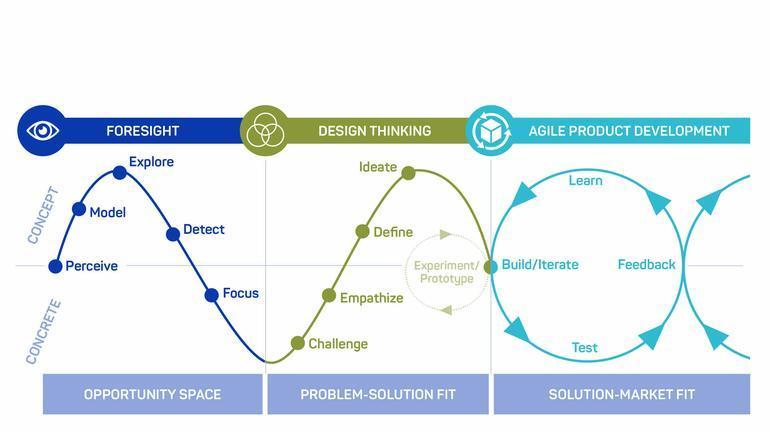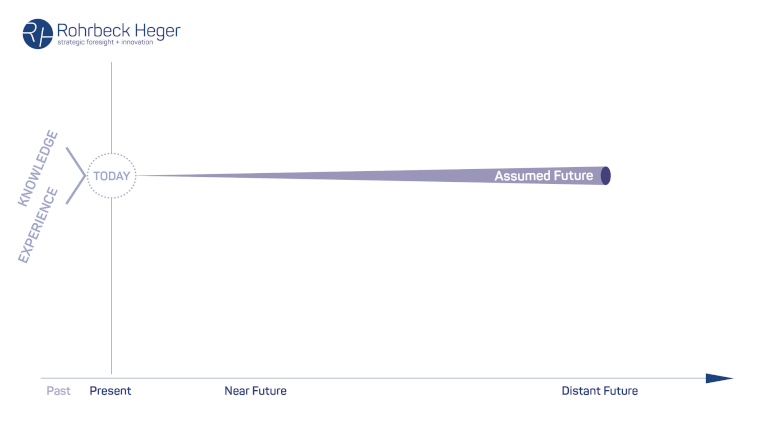
Design Thinking, Agile, Lean … how does Foresight fit into the innovation method toolbox?
When it comes to innovation methodologies there is a lot of buzz – and still quite a bit of confusion – around Design Thinking, Scrum, Agile, Lean Startup, Business Model Innovation and a couple of their relatives.
Working on the related but still less famous Foresighting or Futures Thinking, I often get questions like: how does Foresight fit in, is it even relevant or important? What and how can it contribute to innovation capabilities? Aren’t foresight methods way too heavy or academic for the fast-paced business nowadays? All valid questions, so this is an attempt to answer some of them.
How does Foresight fit into the already crowded innovation toolbox?
Gartner, the Board of Innovation, HPI and many others have discussed the relation of Design Thinking, Design Sprints, the Lean Startup, and so on to great lengths by now. I personally like Geert Claes’ short take on it, as he moves the discussion away from right-or-wrong to looking at it as a method and technique toolbox.

But how does Foresight now fit into the innovation spectrum? In short: Foresight focusses on opportunity detection instead of problem-solution-market fit – i.e. Foresight addresses the (fuzzy) front end of innovation. It aims at identifying a time or a set of circumstances that might enable future product or service opportunities, in Design Thinking terms a challenge that needs to be translated into more concrete solutions. Thus, Foresight can set the stage for other practices such as Design Thinking, but basically: it complements and doesn’t compete.
Most methods from the innovation spectrum range from exploring a problem space, to finding possible solutions for the problem(s), before iterating the best solution to fit the market, finding the best business model, and preparing to scale. But what if you’re looking for a new field to explore, or a field of the future? More and more Innovation Managers tell me something like this:
„We have done plenty of sprints over the course of the last few years. I feel that we have solution concepts for most current and foreseeable problems that are relevant for us. For these, it’s a matter of execution now which is out of our hands. My key question has become: what are the opportunities of the future?“
Foresight will not give you the opportunity of the future. Rather, it let’s you open up an Opportunity Space, a field that is not as broad as for example the future of learning but also not quite a specific problem, pain, or gain that can directly be addressed with a solution. Foresight’s methods and tools such as Horizon Scanning, Drivers of Change, Impact-Uncertainty and Cross-Impact Analyses, Opportunity Radars, Finding the Future Me, Scenario-based Innovation and/or Business Modelling, the Future’s Wheel, Future Experience Groups and Future Fitness Tests can extend the common innovation toolkit at the front end.
Why is foresight not an academic exercise, and how does it contribute to the innovation capabilities?
The range of foresight methods enable us to open up an opportunity space, by understanding and exploring the possibilities through modeling complex systems, identifying possible opportunities, and eventually focusing on the most promising ones.
Just like Design Thinking, Lean Startup, and Scrum, Foresighting has both conceptual and more concrete steps (see figure above). The first steps are usually on a conceptual plane, driven by trends, technological or societal change, environmental, legal or political uncertainty, own observations, and sometimes simply expectations or anxiety of what’s to come. Through scenarios, for example, we can model possible and plausible future states – scenarios give us for example the Futures Cone (see figure below and J. Voros’ explanations here). Through the long-term perspective in scenarios we can systematically identify the problem areas of the future. We can address questions like: where will future problems lie, where do opportunities lie, what are threats to our products, services, segments or possibly our whole industry? These first steps support us in understanding the impact of change, not only in general but in the context of our organization.
However, truly value-creating Foresight practices do not end here. If applied the right way, Foresight supports us (companies) in becoming more concrete about the future by identifying the most promising opportunities – based on our assets, our capabilities, our network and ambitions.
At this point we can focus on opportunities in a more limited scope. These opportunities can begin to be understood as a design challenge or a problem – an optimal starting point for applying human-centred design methods such as Design Thinking or future market research methods such as (Future) Experience Groups.
Design Thinking, for example, has proven to be a suitable method when we want to understand the problem space, identify a clear need (empathize), explore and test possible solutions in an iterative way.
However, a foresight-based approach can address common criticisms or drawbacks of Design Thinking: its narrow focus on the present, preservation of the status quo, and unsuitability for uncertainty – as put forward by Natasha Iskander in her article in Harvard Business Review. Foresight methods, especially scenario-based approaches, are developed to cope with uncertainty and are often designed as participatory approaches – thus focusing on the future and the inherent uncertainty of an outlook, and valuing a plurality of perspectives.

Agile product development methods such as Lean Startup and Scrum are a perfect match as working methods to ensure continuous market-solution fit once an initial solution has been developed. In this stage, results from the initial Foresight stage can also be reused to test against alternative futures, i.e. scenarios. This way, early adaptation to future needs and robustness can be ensured and Foresight’s use spans way beyond the fuzzy front end of innovation to later development stages.
And what about the heaviness? Am I looking at massive transformational processes before I will see any results?
In highly future-prepared companies, Foresight practices and processes are deeply integrated into the organization. My co-founder René has conducted multiple studies on how well-established Foresight is integrated in organizations, and publishes results on a regular basis (see here). But it takes time to deploy Foresight practices holistically and embed them in an organization. Fortunately, there are different ways to Foresight. Lightweight Foresight activities in a masterclass, workshop, bootcamp or sprint format can easily get you started with foresighting. They will not change your whole company – but they are also not supposed to. Instead, they might give you valuable ideas for the future.
Conclusion / TLDR
Foresight or Futures Thinking for innovation is about exploring and understanding the future to steer the exploration and exploitation phases of innovation. Many innovation methodologies and techniques can add great value in understanding concrete problems, finding solutions and iterating to a perfect market-fit in the present. Foresight-driven innovation will help you in identifying the opportunity space of the future.
